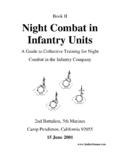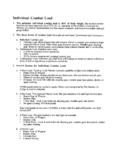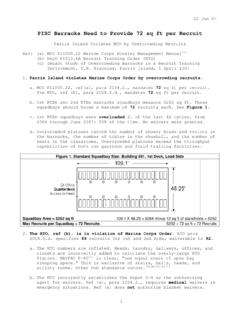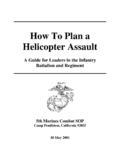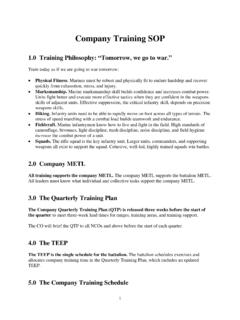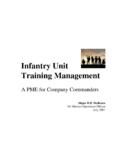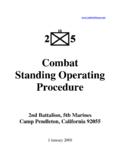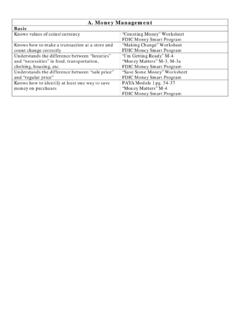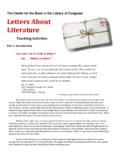Transcription of The Squad Leader Makes the Difference - Advisor …
1 The Squad Leader Makes the Difference Readings on Combat at the Squad Level Volume I Lieutenant Obalde and Lieutenant Otero United States Marine Corps Marine Corps Warfighting Lab Marine Corps Combat Development Command Quantico, Virginia 22134 August 19981 United States Marine Corps Marine Corps Warfighting Lab Marine Corps Combat Development Command Quantico, Virginia 22134 May 1998 FOREWORD In combat, the actions of individual leaders affect the outcome of the entire battle. Squad leaders make decisions and take actions which can affect the operational and strategic levels of war. Well-trained Squad leaders play an important role as combat decisionmakers on the battlefield. leaders who show initiative, judgment, and courage will achieve decisive results not only at the Squad level, but in the broader context of the battle. Without competent Squad leaders , capable of carrying out a commander s intent, even the best plans are doomed to failure.
2 This publication illustrates how bold, imaginative Squad leaders impact the outcome of a battle or campaign. The historical examples here represent some of the cases in which Squad leaders were able to change the course of history. In each case, the Squad Leader had to make a quick decision without direct orders, act independently, and accept responsibility for the results. Short lessons are presented at the end of each story. These lessons should help you realize how important your decisions are to your Marines and your commander. In combat, you must think beyond the Squad level. You must develop opportunities for your commander to exploit. Your every action must support your commander s intent. You must be competent in the combat skills required of a combined arms Leader . You are the primary warfighter of the Marine Corps. 2 The most brilliant depends for its tactical execution on the [ Squad ] leaders . Poor [ Squad ] leaders may ruin the best-laid plans; first-rate [ Squad ] often save badly devised The [ Squad ] Leader is the sole level of command that direct contact with the men who [do] the actual fighting.
3 It follows, then, that the [ Squad ] Leader is to be trained as a tactical commander and as an educator of his men. [Emphasis added] [In the IDF]..[ Squad ] leaders are trained to command independently in the in small, dispersed levels of command be trained to think and act weapons, which provide small groups of greater firepower flexibility of movement, call for a high standard of command at all levels. The [ Squad ] Leader is therefore to be trained technically as an officer, not as a corporal. Yigal Allon Field Commander Israeli Defense Force 3 Table of Contents Foreword Corporal Alvin York Army France, 1918 Sergeant Henry Hanneken Marine Corps Haiti, 1919 Sergeant Wenzel German Army Belgium, 1940 Sergeant Rubarth German Army France, 1940 Sergeant John Basilone Marine Corps Guadalcanal, 1942 Sergeant Jacob Pavlov Russian Army Stalingrad, 1942 Sergeant Thornton British Army France 1944 Sergeant Stephen Gregg Army Italy, 1944 Corporal David W.
4 Lamb Army Korea, 1951 Sergeant First Class Army Vietnam, 1966 Sergeant David C. Freeman Army Vietnam, 1966 Sergeant Stephen Bouchard Marine Corps Vietnam, 1967 Corporal Lester A. Tully Marine Corps Vietnam, 1968 Sergeant Joe Hooper Army Vietnam, 1968 Corporal Gregory Marine Corps Vietnam 1971 Corporal Abols British Army Falklands, 1982 4 Corporal Alvin York Army France, 1918 The Meuse-Argonne offensive was the last important battle of the First World War. On the night of 25 September 1918, over one million American soldiers moved up to relieve the French forces on the front lines. The American advance that ensued swept easily through the first two lines of German trenches, and then progress slowed. Facing stiff resistance, the reserve division was called up. Cpl Alvin York served as an infantryman in the 82nd Division. York s company started across a valley at six in the morning. As they began to move, the company came under heavy fire.
5 From behind a hill, enemy machine guns mowed down the first wave of advancing Americans. No one knew where the deadly fire was coming from, so York s Platoon Sergeant decided to take the platoon on a mission to find it. The platoon found a gap in the enemy lines and circled to the rear of where they thought the machine guns might be. The group of Americans stumbled across two German litter bearers, whom they followed back to the headquarters of the machine gun battalion. The Americans walked right into the German machine gun command post, opened fire, and the Germans immediately surrendered. Upon hearing the firing behind them, the Germans that were dug in near the command post swung their weapons around and began firing at the Americans. Caught in the open, in a hail of automatic fire, the Americans instantly took casualties. Cpl York took aim at the nearest machine gun, about 25 yards away, and killed the man behind the gun. He continued to fire at each German who popped his head out of a foxhole.
6 After watching his troops being massacred by this lone sharpshooter, the German Major in command yelled to York, If you ll stop shooting, I ll make them surrender. Within minutes, the remaining American troops had captured ninety German prisoners, but they were behind enemy lines. Cpl York took charge, and quickly organized his platoon. He decided to move back towards friendly positions, straight through the German lines. York ordered the German prisoners to carry back the American wounded. Every time the group came upon a German position, York told the captured German Major to order the troops to surrender. The well-disciplined German soldiers never questioned the order, and by the time York s small band reached friendly lines, they had acquired 132 German prisoners. In their wake, York s 5 platoon left thirty-five deserted German machine gun positions and a significant gap in the German defenses. This gap which York had created was a vital element to the success of the division s advance.
7 This advance gave momentum to the American forces, and contributed to the success of the Meuse-Argonne offensive. Lessons Cpl York was quick to exploit the opportunity which had been created. He realized that his actions would affect the outcome of the battalion s advance and made decisions which supported his commander s intent. His strong situational awareness guided him in taking action which had decisive results. After taking charge of the platoon, Cpl York led his unit back to friendly lines. His plans changed as the situation developed, but his decisiveness, improvisation skills, and leadership abilities enabled him to lead his withered platoon back to friendly lines while capturing 132 prisoners. 6 Sergeant Henry Hanneken Marine Corps Haiti, 1919 Following serious rebel uprisings, the United States began a prolonged occupation of Haiti in 1915. Charlemagne Peralte was the Leader of the rebel army, known as the Cacos.
8 The 2d Marine Brigade spent several months in unsuccessful attempts to topple Charlemagne s group. Henry Hanneken, a sergeant in the brigade, devised a bold plan to separate Charlemagne from the bulk of his troops and ambush him. Sgt Hanneken sent one of his most reliable men to become a member of the Caco band. In a short period of time the infiltrator had earned the outlaws trust. Then Sgt Hanneken had his spy feed the Cacos the location of a Marine unit that was vulnerable to attack. Hanneken s spy soon returned with information of a rebel plan to attack these Marines, as well as Charlemagne s location during this attack. On 31 October 1919, Sgt Hanneken led 22 local militiamen in an attack on Charlemagne. Disguised as rebels, Hanneken and his unit moved through several guard posts and boldly walked into the unsuspecting rebel camp. When he was within fifteen yards of Charlemagne, Sgt Hanneken drew his pistol, and shot and killed the rebel Leader .
9 In the fire-fight that followed, the small raiding party captured the rebel position and defended it from a series of counterattacks. The Marines who were the target of the rebel attack had been warned by Sgt Hanneken of the impending strike and were well prepared for the rebel attack. The rebels were thoroughly defeated. The morning after the actions, Sgt Hanneken reported his exploits to his commanding officer. Hanneken s actions had routed more than a thousand outlaws, killed their Leader , and virtually shattered the entire bandit resistance movement in northern Haiti. For his actions, Sgt Hanneken was awarded the Medal of Honor. 7 Lessons Sgt Hanneken displayed outstanding initiative and tactical proficiency in devising and acting upon a plan to defeat a large rebel force. This plan supported the brigade s mission in Haiti. Sgt Hanneken accepted great risk, but displayed the courage and nerve to see his plan through. His bold action achieved decisive results.
10 With a small band of men, Sgt Hanneken was able to defeat a larger rebel force by adhering to tactical fundamentals. His 22-man Main Effort attacked the enemy Center of Gravity, the rebel Leader . Without leadership, the rebel force quickly disintegrated. Sgt Hanneken used the elements of surprise and deception to execute his attack. Surprise is one of the most important tactical fundamental and was essential to this tactical undertaking. Sgt Hanneken s actions illustrate how tactical decisions at the Squad level can impact the operational and strategic levels of war, and can ultimately affect policy. Sgt Hanneken s attack greatly affected the balance of power in Haiti, lessening the turmoil in the country. It was a major step towards ending the rebellion on the island. The prospect of surprise is always the surest guarantee of victory. von Mellenthin No tactical action should ever be undertaken without the element of surprise.
